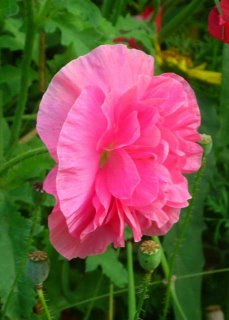 What’s blooming in the area: Apache plume, Illinois bundle flower, datura, buffalo gourd, stickleaf, white evening primrose, velvetweed, wild lettuce, white sweet clover, golden hairy aster, Queen Anne’s lace, bigleaf globeflower, bindweed, goat’s head, toothed spurge, rose of Sharon, purple phlox, daylily, roses, sweet pea, bouncing Bess, pink evening primrose, trumpet creeper, silverlace vine, muhly ring grass.
What’s blooming in the area: Apache plume, Illinois bundle flower, datura, buffalo gourd, stickleaf, white evening primrose, velvetweed, wild lettuce, white sweet clover, golden hairy aster, Queen Anne’s lace, bigleaf globeflower, bindweed, goat’s head, toothed spurge, rose of Sharon, purple phlox, daylily, roses, sweet pea, bouncing Bess, pink evening primrose, trumpet creeper, silverlace vine, muhly ring grass.What’s blooming in my garden, looking north: Black eyed Susan, blanket flower, golden spur columbine, lance-leaf coreopsis, chocolate flowers, perky Sue, Hartweg evening primrose, fern-leaf yarrow, Mexican hat, butterfly weed, miniature rose (Rise and Shine), creeping zinnia.
Looking east: Biennial yellow evening primrose, California poppy, winecup, small and large flowered soapworts, coral beardtongue, holly hock, Shirley poppy, sweet alyssum.
Look south: Zinnia, crimson rambler morning glory, sensation cosmos, blaze and rugosa roses.
Look west: Perennial four o’clock, purple coneflower, white spurge, frikarti aster, lead plant, catmint, blue flax, sea lavender, Russian sage, purple ice plant, caryopteris.
Bedding plants: Dalhburg daisies, marigolds, sweet alyssum, snapdragons, petunias, profusion zinnias, supersweet 100 tomato, zucchini.
Animal sightings: Small hummingbird still mining the coral beardtongue; ants dragon fly; large grasshoppers back, probably migrating in from prairie; birds and crickets are heard but hidden.
Weather: Hot days, cool nights; passing storms bring water in the air, but none in the ground.
Weekly update: One perfect poppy, coral pink in the sun, justifies all the seed scattered to the wind for a decade.
The Shirley poppy, with three layers of petals, resembled a peony with its slightly ruffled petals standing at various heights to hide the center when it opened last Sunday morning. It was fading Monday night, gone when I got home on Tuesday. Some petals on the ground, a seed capsule, and four buds promising more.
I started growing poppies to the east of the house around 1997 when I put some Thompson and Morgan seed it that had been lying around for a couple years. It grew, reseeded, and continued to grow through 1999.
When I went to order more, I discovered the company had stopped selling that particular seed. So I tried others from Stokes and Wildseed, from Lake Valley and Northrup King, Burpee and even Ferry Morse when it was available. At best, a few flowers each year, no reseeds, no success like my first year.
I blamed myself, planted in the fall, on the snow, early spring, summer if there were leftovers. Nothing. I considered all the seed predators, the gopher burrowing under the bed, the convoys of ants, the voracious rabbit.
Then I blamed the wind, which howls along the eastern fence. Last year, dozens of plants came up beyond my gate in the bed my neighbor was developing for wildflowers. I didn’t know if it was my seed or hers. Then, just as they were ready to bloom, she yanked them. Apparently, no volunteers were wanted among the wildflowers.
This year, too late to help, I put up the southern fence to moderate the wind.
With all the seed and all the experiments, I have no idea who gave me the poppy. Most likely it’s a Ryburgh hybrid, but it could be anything; the seed can lie dormant for decades. I have one tall single orange plant that’s 20" high, when most of the single red and orange flowers are 12". This one was 18" while the tiny pink flowers are about 7". A few are double, most are single; a few have yellow anthers, most are black.
Shirley poppies were derived from red corn poppies which anthropologists speculate evolved in southern or eastern Europe and traveled with humans in the bronze age. Why is more elusive. They may have hidden in more valuable seed, they may have been grown for their seed which produces oil, still used in Germany and Austria. Rhoeadine, a mild sedative used in cough syrups and French aperitifs, can be hypnotic in larger doses.
William Wilks assumed the vicarage in Shirley, England, in 1879. The next year he noticed one flower had "had a very narrow edge of white." Educated at Oxford before natural history and natural theology diverged, he’d become a fellow of the Royal Horticultural Society in 1867, the year after he was ordained.
He saved the seed and began experimenting with selective breeding, until he had removed the characteristic blotch at the base, and changed the stamens and anthers to yellow or white. He retired to the RHS just a few years before Joel McCrae’s poem, "In Flanders’ Fields," produced a commercial market for the red flower.
Others continued his work, producing pinks and oranges, whites and pastels, picotee and solid colors of all heights, singles and doubles. Most of my seed probably comes from the United States and is open-pollinated. Some has come from Holland and Germany, and may be sterile hybrids.
Apart from its medicinal use, Papaver rhoeas has had no place in agriculture, except as a nuisance at harvest time. Mayfair Drugs tells us, it has no scent, produces no honey. It relies only on its "short lived, brilliant colour" to attract insects to pollinate it.
Only on its beauty. What more does an insect or bronze age human need? Why else do we garden?
Notes:Mayfair Drugs. "In Flanders Fields where poppies blow...," available on-line.
McCrae, Joel. "In Flanders Fields" (1915).
Wilks, William. Quoted by Croydon, "The Old Vicarage," available on-line.
No comments:
Post a Comment